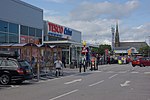Duke Street, Barrow-in-Furness
Streets in Barrow-in-FurnessUse British English from August 2017

Duke Street is a road running through the town centre and Hindpool area of Barrow-in-Furness, England. Stretching almost one mile from east to west it connects two major A roads as well as intersecting Abbey Road roughly midway. Designed by Sir James Ramsden as the centrepiece of the 19th century planned town of Barrow, Duke Street is home to three squares (Ramsden Square, Town Square and Schneider Square) alongside many listed buildings including Barrow Town Hall and the Main Public Library. The Forum performing arts centre and Craven Park Stadium (home of the rugby league side Barrow Raiders) are also located on Duke Street.
Excerpt from the Wikipedia article Duke Street, Barrow-in-Furness (License: CC BY-SA 3.0, Authors, Images).Duke Street, Barrow-in-Furness
Duke Street,
Geographical coordinates (GPS) Address Nearby Places Show on map
Geographical coordinates (GPS)
| Latitude | Longitude |
|---|---|
| N 54.112992 ° | E -3.229642 ° |
Address
Duke Street / Cavendish Street
Duke Street
LA14 1RW , Hindpool
England, United Kingdom
Open on Google Maps







